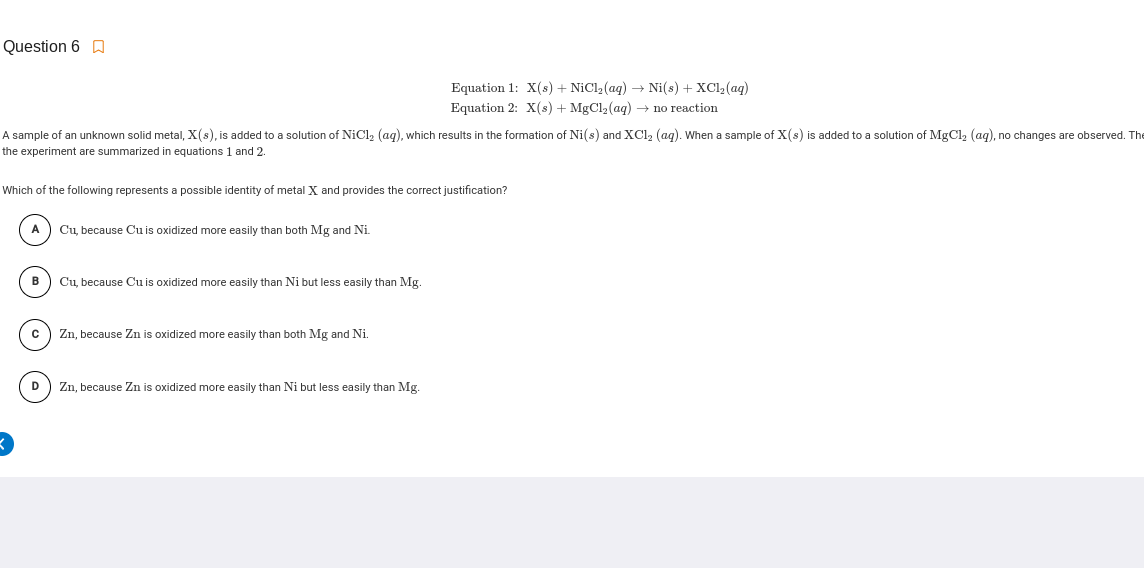Question 6 A Equation 1: X(s) + NiCl (aq) → Ni(s) + XCl, (ag) Equation 2: X(s) + MgCl2 (ag) → no reaction A sample of an unknown solid metal, X(s), is added to a solution of NiCl, (ag), which results in the formation of Ni(s) and XCI2 (ag). When a sample of X(s) is added to a solution of MgCl, (ag), no changes are observed. The the experiment are summarized in equations 1 and 2. Which of the following represents a possible identity of metal X and provides the correct justification? Cu, because Cu is oxidized more easily than both Mg and Ni. Cu, because Cu is oxidized more easily than Ni but less easily than Mg. Zn, because Zn is oxidized more easily than both Mg and Ni. D Zn, because Zn is oxidized more easily than Ni but less easily than Mg.
Question 6 A Equation 1: X(s) + NiCl (aq) → Ni(s) + XCl, (ag) Equation 2: X(s) + MgCl2 (ag) → no reaction A sample of an unknown solid metal, X(s), is added to a solution of NiCl, (ag), which results in the formation of Ni(s) and XCI2 (ag). When a sample of X(s) is added to a solution of MgCl, (ag), no changes are observed. The the experiment are summarized in equations 1 and 2. Which of the following represents a possible identity of metal X and provides the correct justification? Cu, because Cu is oxidized more easily than both Mg and Ni. Cu, because Cu is oxidized more easily than Ni but less easily than Mg. Zn, because Zn is oxidized more easily than both Mg and Ni. D Zn, because Zn is oxidized more easily than Ni but less easily than Mg.
Chemistry: Principles and Reactions
8th Edition
ISBN:9781305079373
Author:William L. Masterton, Cecile N. Hurley
Publisher:William L. Masterton, Cecile N. Hurley
Chapter4: Reactions In Aqueous Solution
Section: Chapter Questions
Problem 73QAP: Copper metal can reduce silver ions to metallic silver. The copper is oxidized to copper ions...
Related questions
Question

Transcribed Image Text:Question 6 A
Equation 1: X(s) + NiCl (aq) → Ni(s) + XCl, (ag)
Equation 2: X(s) + MgCl2 (ag) → no reaction
A sample of an unknown solid metal, X(s), is added to a solution of NiCl, (ag), which results in the formation of Ni(s) and XCI2 (ag). When a sample of X(s) is added to a solution of MgCl, (ag), no changes are observed. The
the experiment are summarized in equations 1 and 2.
Which of the following represents a possible identity of metal X and provides the correct justification?
Cu, because Cu is oxidized more easily than both Mg and Ni.
Cu, because Cu is oxidized more easily than Ni but less easily than Mg.
Zn, because Zn is oxidized more easily than both Mg and Ni.
D
Zn, because Zn is oxidized more easily than Ni but less easily than Mg.
Expert Solution
This question has been solved!
Explore an expertly crafted, step-by-step solution for a thorough understanding of key concepts.
This is a popular solution!
Trending now
This is a popular solution!
Step by step
Solved in 2 steps with 2 images

Knowledge Booster
Learn more about
Need a deep-dive on the concept behind this application? Look no further. Learn more about this topic, chemistry and related others by exploring similar questions and additional content below.Recommended textbooks for you

Chemistry: Principles and Reactions
Chemistry
ISBN:
9781305079373
Author:
William L. Masterton, Cecile N. Hurley
Publisher:
Cengage Learning

Chemistry & Chemical Reactivity
Chemistry
ISBN:
9781133949640
Author:
John C. Kotz, Paul M. Treichel, John Townsend, David Treichel
Publisher:
Cengage Learning

Chemistry & Chemical Reactivity
Chemistry
ISBN:
9781337399074
Author:
John C. Kotz, Paul M. Treichel, John Townsend, David Treichel
Publisher:
Cengage Learning

Chemistry: Principles and Reactions
Chemistry
ISBN:
9781305079373
Author:
William L. Masterton, Cecile N. Hurley
Publisher:
Cengage Learning

Chemistry & Chemical Reactivity
Chemistry
ISBN:
9781133949640
Author:
John C. Kotz, Paul M. Treichel, John Townsend, David Treichel
Publisher:
Cengage Learning

Chemistry & Chemical Reactivity
Chemistry
ISBN:
9781337399074
Author:
John C. Kotz, Paul M. Treichel, John Townsend, David Treichel
Publisher:
Cengage Learning

Chemistry: The Molecular Science
Chemistry
ISBN:
9781285199047
Author:
John W. Moore, Conrad L. Stanitski
Publisher:
Cengage Learning

General Chemistry - Standalone book (MindTap Cour…
Chemistry
ISBN:
9781305580343
Author:
Steven D. Gammon, Ebbing, Darrell Ebbing, Steven D., Darrell; Gammon, Darrell Ebbing; Steven D. Gammon, Darrell D.; Gammon, Ebbing; Steven D. Gammon; Darrell
Publisher:
Cengage Learning